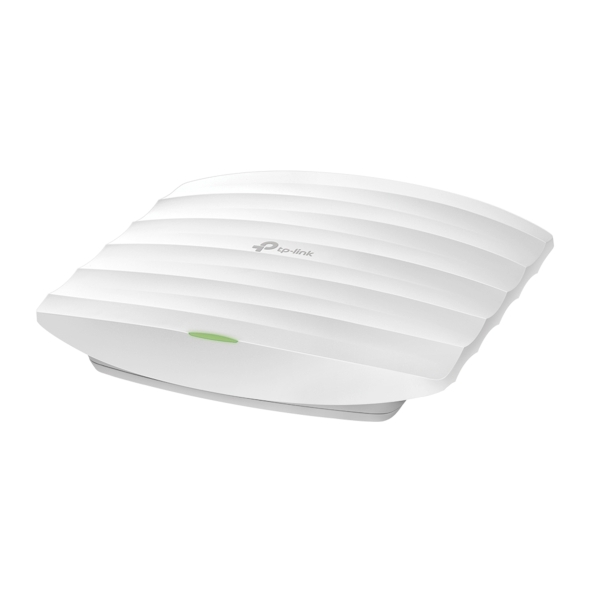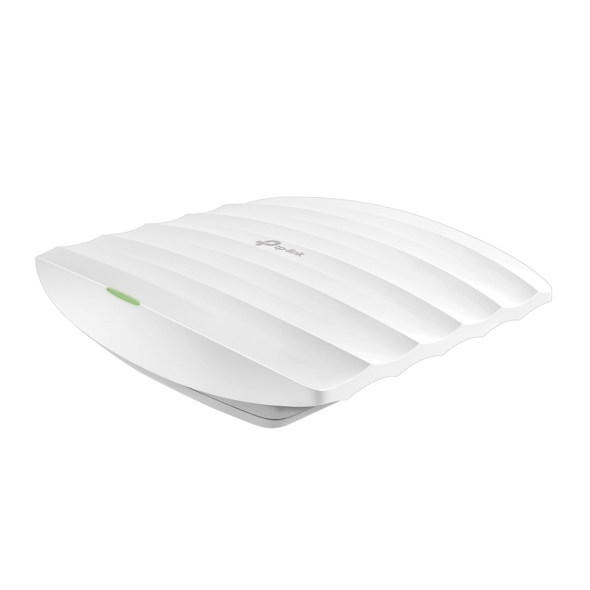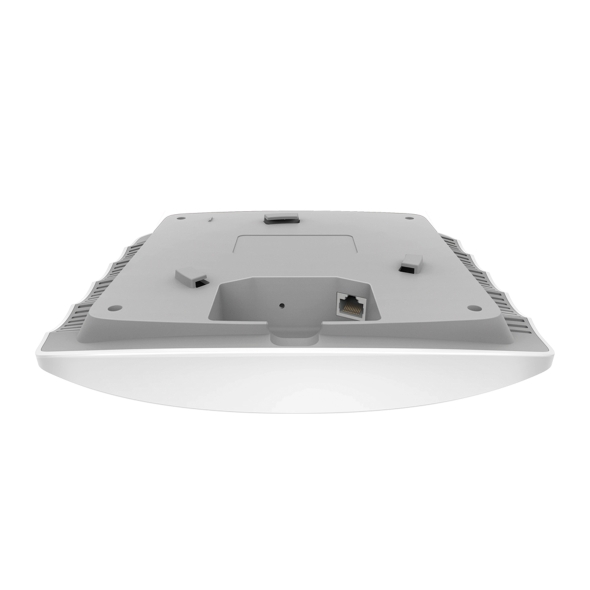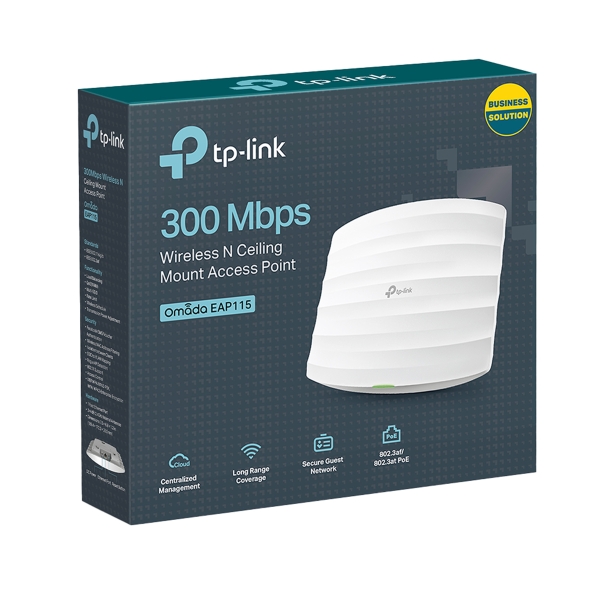EAP115
300Mbps Wireless N Ceiling Mount Access Point
- Integrated into Omada SDN: Centralized Cloud Management, and Intelligent Monitoring.
- Centralized Management: Cloud access and Omada app for ultra convenience and easy management.
- PoE Support: Supports Power over Ethernet (802.3af/at) for convenient deployment.
- Easy Installation: Simple mounting design for easy attachment to a wall or ceiling.
- Secure Guest Network: Along with multiple authentication options (SMS/Facebook Wi-Fi/ Voucher, etc.) and abundant wireless security technologies.
- Load Balancing: Limit the number of users on each access point and remove devices with weak reception to keep your Wi-Fi running at peak performance.
- Scheduling: Automatically reboot the access point and turn on or off the Wi-Fi at the time you set.
An Affordable, Scalable Business Wi-Fi Solution
300Mbps Wireless N Ceiling Mount Access Point
Seamless Integrated into Omada SDN Platform
The Omada Software Defined Networking (SDN) platform integrates network devices including access points, switches, and routers to create a highly scalable network—all controlled from a single interface.
- Hardware or Software Controllers
- Centralized Management
- Intelligent Monitoring
Wi-Fi 6 AP for High-Density Environments
Ceiling Mount AP
Wall Plate AP
Outdoor AP
Omada PoE Switch
Omada Hardware Controller
Or
Omada Software Controller
Web Browser
Omada App
Cloud Access
Internet
Omada VPN Gateway
Captive Portal
Guest Network with SMS Support
The captive portal helps maintain only authorized guests to use the network, presenting devices with a convenient, user-friendly authentication method to grant Wi-Fi access. The addition of SMS authentication simplifies the captive portal even further to simplify connectivity and boost your business.*
Easy Mount Design and PoE
Timesaving and Flexible Deployment
The Omada EAP115 is designed for easy installation on any wall or ceiling. The Power over Ethernet (PoE) function allows your network cables to carry electrical power so you minimize cable clutter. It’s one more hardwiring hassle you don’t have to worry about when operating your centralized management system.
Easy Management with the Omada App
Follow configuration instructions on the free Omada app to get set up in minutes. Omada lets you configure settings, monitor the network status and manage clients, all from the convenience of a smartphone or tablet.
| Interface | 1× Fast Ethernet (RJ-45) Port (Support IEEE802.3af PoE) |
|---|---|
| Button | Reset |
| Power Supply | 802.3af PoE or external 9VDC/0.6A power supply |
| Max. Power Consumption | 2.8 W |
| Dimensions ( W x D x H ) | 7.5×6.7×1.2 in (189.5×170.5×29.7mm) |
| Antenna | Internal 2× 4 dBi Omni |
| Mounting | Ceiling /Wall Mounting (Kits included) |
| Coverage | 60㎡(650ft²)§ |
|---|---|
| Concurrent Clients | 100+** |
| Wireless Standards | IEEE 802.11n, IEEE 802.11g, IEEE 802.11b |
| Frequency | 2.4–2.4835 GHz |
| Signal Rate | • 11n: Up to 300Mbps(dynamic)• 11g: Up to 54Mbps(dynamic)• 11b: Up to 11Mbps(dynamic) |
| Reception Sensitivity | • 300M: -71dBm@10% PER• 150M: -75dBm@10% PER• 54M: -78dBm@10% PER• 11M: -93dBm@8% PER• 6M: -92dBm@10% PER• 1M: -96dBm@8% PER |
| Wireless Functions | • Multiple SSIDs (Up to 8 SSIDs)• Enable/Disable Wireless Radio• Automatic Channel Assignment• Transmit Power Control (Adjust Transmit Power on dBm)• QoS(WMM)• Rate Limit• Reboot Schedule• Wireless Schedule• Wireless Statistics based on SSID/AP/Client |
| Wireless Security | • Captive Portal Authentication• Access Control• Wireless MAC Address Filtering• Wireless Isolation Between Clients• SSID to VLAN Mapping• Rogue AP Detection• 802.1X Support• 64/128/152-bit WEP / WPA / WPA2-Enterprise,WPA-PSK / WPA2-PSK |
| Transmission Power | • CE:≤19 dBm (EIRP)• FCC:≤21 dBm |
| Omada App | Yes |
|---|---|
| Centralized Management | • Omada Hardware Controller• Omada Software Controller |
| Cloud Access | Yes (Through OC300, OC200, or Omada Software Controller) |
| Email Alerts | Yes |
| LED ON/OFF Control | Yes |
| Management MAC Access Control | Yes |
| SNMP | v1,v2c |
| System Logging Local/Remote Syslog | Local/Remote Syslog |
| SSH | Yes |
| Web-based Management | HTTP/HTTPS |
| L3 Management | Yes |
| Multi-site Management | Yes |
| Management VLAN | Yes |
| Certification | CE, FCC, RoHS |
|---|---|
| Package Content | • 300Mbps Wireless N Ceiling Mount Access Point EAP115• Power Adapter• Mounting Kits• Installation Guide |
| System Requirements | Microsoft Windows 11/10/8/7/Vista/XP, Linux |
| Environment | • Operating Temperature: 0–40 ℃ (32–104 ℉)• Storage Temperature: -40–70 ℃ (-40–158 ℉)• Operating Humidity: 10–90% RH non-condensing• Storage Humidity: 5–90% RH non-condensing |
†Maximum wireless signal rates are the physical rates derived from IEEE Standard 802.11 specifications. Actual wireless data throughput and wireless coverage are not guaranteed and will vary as a result of 1) environmental factors, including building materials, physical objects, and obstacles, 2) network conditions, including local interference, volume and density of traffic, product location, network complexity, and network overhead, and 3) client limitations, including rated performance, location, connection, quality, and client condition.

















